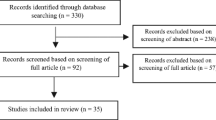Abstract
We present an overview of the methodology employed in the Parents Matter! Program. Information on the following aspects of the program is presented: participant eligibility and recruitment; consenting procedures and administration of assessments; development and utilization of measures in the assessments; study design; intervention procedures; facilitator characteristics and training; procedures to assess treatment fidelity assessment; and procedures utilized to enhance retention of study participants.
Similar content being viewed by others
REFERENCES
Achenbach, T.M. (1991). Manual for the Child Behavior Checklist 4-18 and 1991 profile. Burlington, VT: Department of Psychiatry, University of Vermont.
Achenbach, T.M. (1991). Manual for the Youth Self-Report and 1991 profile. Burlington, VT: Department of Psychiatry, University of Vermont.
Andrews, F.M., & Withey, S.B. (1976). Social indicators of well-being: American's perceptions of life quality. New York: Plenum.
Armistead, L., Clark, H., Barber, N., Hugley, J., Dorsey, S., & Favors, M. (2004). Participant retention in the Parents Matter! Program: Strategies and outcome. Journal of Child and Family Studies, 13, 67-80.
Barnes, H.L., & Olson, D. H. (1985). Parent-adolescent communication and the circumplex model. Child Development, 56, 438-447.
Campis, L.K., Lyman, R., & Prentice-Dunn, S. (1986). The Parental Locus of Control Scale: Development and validation. Journal of Clinical Child Psychology, 15, 260-267.
Cohen, S., Kamarck, T., & Mermelstein, R. (1983). A global measure of perceived stress. Journal of Health and Social Behavior, 24, 385-396.
Conger, R.D., Conger, K.J., Elder, G.H., Jr., Lorenz, F.O., Simons, R.L., & Whitbeck, L.B. (1992). A family process model of economic hardship and adjustment of early adolescent boys. Child Development, 63, 526-541.
Dittus, P., Miller, K. S., Kotchick, B. A., & Forehand, R. (2004). Why Parents Matter!: The conceptual basis for a community-based HIV prevention program for the parents of African American youth. Journal of Child and Family Studies, 13, 5-20.
Family Health Project Research Group. (1998). The family health project: A multidisciplinary longitudinal investigation of children whose mothers are HIV infected. Clinical Psychology Review, 18, 839-856.
Hall, J.A., & Halberstadst, A.G. (1981). Sex roles and nonverbal communication. Sex Roles, 3, 273-287.
Hansen, W.B., Paskett, E.D., & Carter, L.J. (1999). The Adolescent Sexual Activity Index (ASAI): A standardized strategy for measuring interpersonal heterosexual behaviors among youth. Health Education Research, 14, 485-490.
Harter, S. (1982). The Perceived Competence Scale for Children. Child Development, 53, 87-97.
Hoffman, L.W., & Kloska, D.D. (1985). Parent's gender-based attitudes toward marital roles and child rearing: Development and validation of a new measure. Sex Roles, 32, 273-295.
Jaccard, J., Dittus, P., & Gordon, V. (1996). Maternal correlates of adolescent sexual behavior. Family Planning Perspectives, 28, 159-165, 185.
Landesman, S., & Jaccard, J. (1988). Final Report for the Analysis of Family Structure and Family Functioning. Bethesda, MD: National Institute of Health, Center for Population Research.
Long, N., Austin, B-J., Kelly, A., Gardner, A., Dunn, R., Gound, M., Blacknall, & Miller, K. (2004). The PMP interventions: Content and the facilitation process. Journal of Child and Family Studies, 13, 47-65.
Miller, K.M., Forehand, R. & Kotchick, B. (2000). Adolescent sexual risk in two ethnic minority samples: a multi-system perspective delineating targets for prevention. Adolescence, 35, 313-334.
Moore, S. (1985) The children's sex role test. Psychological Reports, 57, 586.
Murry, V. M., Kotchick, B. A., Wallace, S., Ketchen, B., Eddings, K., Heller, L., & Collier, I. (2004). Race, culture, and ethnicity: Implications for a community intervention. (2004). Journal of Child and Family Studies, 13, 81-99.
Petersen, A.C., Crockett, L., Richards, M., & Boxer, A. (1988). A self-report measure of pubertal status: reliability, validity, and initial norms. Journal of Youth and Adolescence, 17, 117-133.
Secrest, L., Lassiter, S., Armistead, L. P., Wycoff, S., Johnson, J., Williams, W. B. & Kotchick, B.A. (2004). The Parents Matter! Program: Building a successful investigator-community partnership. Journal of Child and Family Studies, 13, 35-45.
Shelton, K.K., Frick, P.J., & Wootton, J. (1996). Assessment of parenting practices in families of elementary school-age children. Journal of Clinical Child Psychology, 25, 317-329.
Author information
Authors and Affiliations
Corresponding author
Rights and permissions
About this article
Cite this article
Ball, J., Pelton, J., Forehand, R. et al. Methodological Overview of the Parents Matter! Program. Journal of Child and Family Studies 13, 21–34 (2004). https://doi.org/10.1023/B:JCFS.0000010488.54867.95
Issue Date:
DOI: https://doi.org/10.1023/B:JCFS.0000010488.54867.95




